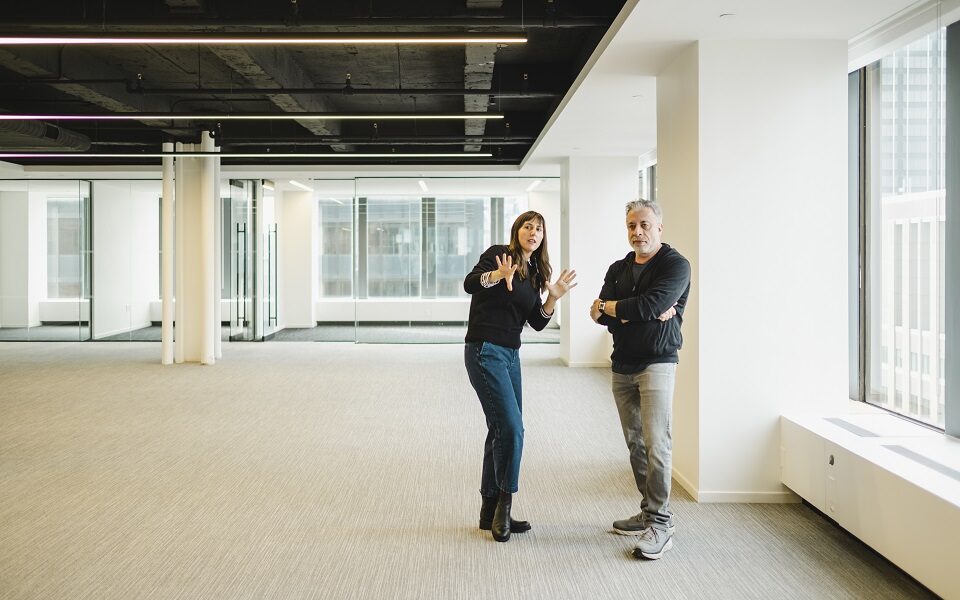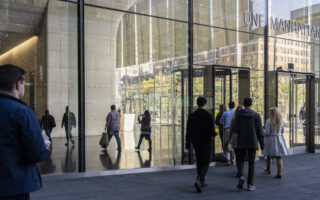Getting creative with vacant office space: Storage, gym, film set

After two years of overhyped return-to-work prognostications, many desks around the nation still sit vacant. But on some empty floors of midtown Manhattan office buildings, unused space has lately been playing a new role: film set.
The transformation from a real-life office into a facsimile on the small screen is part of the business strategy of Backlot, a location service for film and television production in New York, which offers landlords a way to earn revenue from their lifeless cubicles.
The boom in content production and the demand for genuine locations have helped the business take off, said Darren Goldberg, managing partner and head of acquisitions for Backlot. “When you shoot scenes for shows like ‘Billions’ or ‘Succession,’ it’s not just about the one room,” he said. “It’s really about the authenticity of the environment.”
The glut of office space left by the pandemic-induced transition to remote work is expected to remain a stubborn problem in big US cities. The service offered by Backlot is just one of a number of new alternatives being proposed to landlords with empty offices. Some building owners convert office buildings into apartments and life sciences labs as a long-term solution, but others are seeking shorter-term options that are cheaper and easier to manage, such as renovating space to accommodate self-storage, gyms and even schools.
The task is complicated by the rising cost of any type of renovation and the lack of foot traffic in many downtowns and office districts, said Brian Strawberry, chief economist at consulting firm FMI. “Given the situation with rising interest rates, the economic climate and the cost of construction, it’s a big challenge,” he said. “There’s a lot of risk out there.”
Backlot offers film and TV productions easy access to 22 million square feet of offices, restaurants and retail space across New York City. By scouting and prepping locations and handling paperwork and negotiations ahead of time, the company turns empty space into filming locations to feed the voracious demand for content.
For example, when the revival of cult comedy “Party Down” needed to film a quick scene in New York this year, Backlot made it happen. Other Backlot properties have been used in TV shows such as “Harlem,” “The Watcher” and “Law & Order: Special Victims Unit.”
Backlot’s clients include hospitality and real estate companies such as Hines, RXR and Union Square Hospitality. “Commercial office buildings don’t like to interfere with their high-paying tenants, and they don’t want to be bothered by 150 people coming in to shoot a movie or TV show,” Goldberg said.
A deal to place the entire portfolio of real estate investor SL Green on Backlot has generated “millions of dollars for us in incremental revenue over the last several years,” said Steven M. Durels, an executive vice president at the firm, which promotes itself as New York’s largest commercial landlord.
The timing is good for companies such as Backlot that offer alternative uses for commercial real estate. Office rents have recovered from the depths of the recession, but they are still down 6.2% percent on average nationally since 2019, with renewal rates declining significantly, according to a report from JLL, a real estate services firm. A record number of leases are expiring in 2023, forcing landlords to rethink how they fill and earn revenue from their office towers.
The surplus of office space is 20% to 40%, depending on the city, said Tracy Hadden Loh, a fellow at the Brookings Institution who focuses on real estate. “The challenge is that nobody has figured out how to reuse those massive, million-square-foot, ’80s-era office buildings,” she said.
“We need to take this functionally obsolete product that’s still in an amazing location and figure out how to not lose that value,” she added.
Landlords believe they can be creative and flip a switch to solve the problem, but it’s not that simple to reconfigure spaces for new tenants or business concepts, said David Bergeron, an executive vice president for Savills, a real estate services company.
“I think we need to test some of those things out,” he said. “But I would argue 99 out of 100 of these experiments will fail.”
The most common strategy is to convert office towers into apartments or condos. Such conversions increased a record 43% nationwide in 2021, creating 11,090 new apartments, according to research from RentCafe, a division of real estate software firm Yardi Systems.
But residential conversions account for a small fraction of vacant office space. Renovating offices is often prohibitively expensive and stymied by building code requirements and the difficulty of carving bedrooms out of large floor plates.
That hasn’t stopped some startups from trying to find new business models for vacant space. In Seattle and elsewhere, business leaders are experimenting with retail to bring new tenants into downtown spaces, and cities are studying plans to ease residential conversions.
Silofit, a Canadian company that turns former office space into private gyms for personal trainers and their clients, has recently expanded its concept to Miami. And a handful of education startups and charter schools, such as Acton Academy in the Bay Area, have experimented with operating in renovated commercial space.
Downtown office space also has great value for the logistics industry. For example, Neighbor, a peer-to-peer self-storage concept that helps building owners cash in on unused space, has seen significant growth.
The platform exploded in popularity in the past year, said Joseph Woodbury, the CEO and a co-founder of Neighbor. Compared with a year ago, the site now has four times the commercial space that is being actively used for storage.
As landlords look to lease their unoccupied floors and parking garages, more are willing to sign up with Neighbor because they have stopped believing they will attract enough tenants, prolonging a downturn in occupancy rates. “Many owners are starting to come around to realizing it is going to be more severe than we ever expected,” Woodbury said.
Another alternative is to change the way office space is set up and leased, a departure from the traditional model of a large space with a 10-year lease, which has fallen out of favor. Many landlords have turned to prepping spaces for lease so potential tenants have the option of moving in quickly and staying for shorter periods.
Codi, a San Francisco startup, offers what amounts to a timeshare for office tenants by pairing small companies with hybrid schedules so they use the same space on alternate days during a typical week. The business, which manages about 50 locations in the Bay Area and New York, has grown 40% in the past six months.
Codi also just started a service to lease unused commercial space for off-site meetings for companies that have moved to remote work.
“The workplace is going through a massive shift, and companies more than ever value ease and speed and flexibility,” said Codi’s CEO, Christelle Rohaut. “The traditional office experience does not offer that.”
This article originally appeared in The New York Times.






